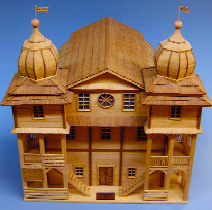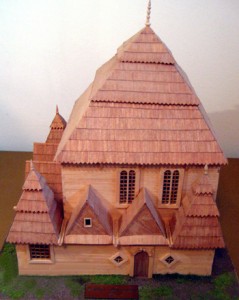Arts
Exhibit
The Arts: Synagogues in Wood

Kornik. Lutomiersk. Przedborz. Obscure today, perhaps, but these Polish cities and countless others with Jewish quarters were home to bustling communities throughout the 1,000-year history of Jewish life in Poland. At the center of this sometimes fragile, sometimes vigorous shtetl existence was the synagogue, often serving a role beyond the religious.
How does one make that history come alive and establish a relevant remembrance for Jews in the United States, 80 percent of whom trace their ancestry to Jews of Poland? In models of 10 ancient synagogues he lovingly crafted, the late Peter Maurice, a British airline pilot and a sculptor in his spare time, created a contemporary link to the architecture of these wooden houses of worship. Over a four-year period beginning in 2003, while suffering through an aggressive cancer, Maurice painstakingly constructed miniature versions of long-ago synagogues. These structures—each different—are on view in an intriguing collection he gave to the Jewish Museum of Florida in Miami Beach (www.jewishmuseum.com). With extensive background information on the communities, they will be on view through March 18.
To say they make history come alive would be an understatement. For 400 years before the start of World War II, Jewish craftsmen, using abundant wood from Poland’s forests, built 1,000 full-scale synagogues, with carved and painted interiors, constructing cupolas and inscribing prayers on panels for those who did not have siddurim. Alas, virtually all of the original wooden synagogues that survived Poland’s calamitous history were destroyed by the Nazis. Some built in the 19th and 20th centuries still stand in Poland and present-day Lithuania, but they are beyond repair. Working from original design plans and old paintings and photographs assembled in a book called Wooden Synagogues, now out of print, Maurice matched the wood at a scale of one-fortieth the actual size of the synagogues.

built c.1610, earliest recorded wooden synagogue.
Some have upright planks, others display braces and supports that are smaller than matchsticks or toothpicks, and some walls and panels seem to defy gravity. Tiny books and candles and delicate chandeliers give the interiors an authentic ring. Maurice worked carefully and meticulously on the models, ultimately finishing 10 before succumbing to cancer in 2007.
To make the exhibition relevant to present-day visitors, the Jewish Museum, now under the leadership of Jo Ann Arnowitz, invited Floridians of Polish origin to contribute photographs, memorabilia and stories of their families’ histories. The contributions, from 40 families, range from original travel documents and naturalization papers to a crucifix worn to fool the Nazis and a picture of a young man in an acolyte church outfit alongside a postwar picture of the boy in his bar mitzva suit.
This exhibition evokes more than the history of the buildings. The synagogues, built by Jews who were otherwise restricted from participating in the building trades or decorative arts, represent a distinct folk architecture. They are an enduring and welcome addition to our cultural heritage.










 Facebook
Facebook Instagram
Instagram Twitter
Twitter
Leave a Reply